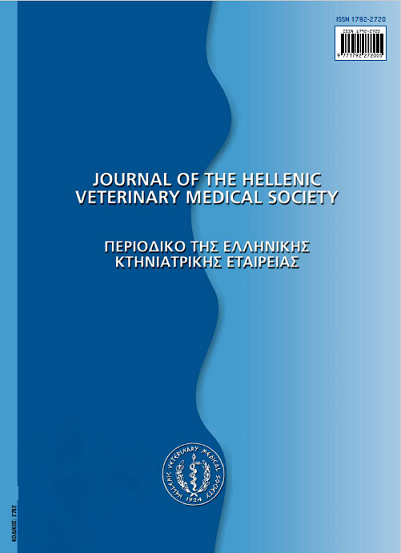Μετάδοση μέσω του θαλασσινού νεροΰ των βακτηριδιακών νοσημάτων των ευρύαλων καλλιεργούμενων ψαριών της Μεσογείου. Στοιχεία επιδημιολογίας και παράγοντες κίνδυνου που αφορούν στη διασπορά και μετάδοση των αντίστοιχων παθογόνων

Περίληψη
Η εντατική ιχθυοκαλλιέργεια που εφαρμόζεται στη Μεσόγειο προϋποθέτει τη διαβίωση των ψαριών σε ένα περιβάλλον όπου, πολλές φορές, επικρατούν συνθήκες καταπόνησης και υψηλές ιχθυοπυκνότητες, κάτι που διευκολύνει τη μετάδοσηκαι διασπορά των παθογόνων βακτηριδίων μέσα στους εκτρεφόμενους ιχθυοπληθυσμούς. Ένα από τα σημαντικότερα μέσα μετάδοσης των βακτηριδιακών νοσημάτων των ευρύαλων ψαριών που καλλιεργούνται στη Μεσόγειο είναι το θαλασσινό νερό. Τα παθογόνα βακτηρίδια, που κυρίως προσβάλουν τα μεσογειακά ευρύαλα καλλιεργούμενα είδη ψαριών, είναι τα: Listonella anguillarum, Photobacterìum damselaesubsppiscicidaTenacibaculummarìtimum, Piscirìkettsiasalmonis, Pseudomonasanguilliseptica καθώς και διάφορα είδη του γένους Vibrio, διάφοροι στρεπτόκοκοι και λακτόκοκοι και είδη του γένους Mycobacterìum. Στο φυσικό περιβάλλον τα βακτηρίδια, τα οποία συνήθως αποβάλλονται από μολυσμένα ψάρια, αφού επιβιώσουν για κάποιο χρονικόδιάστημα στην υδάτινη στήλη και στον πυθμένα της θάλασσας μπορούν στη συνέχεια, όταν συντρέχουν οι κατάλληλες συνθήκες, να μολύνουν άλλα, καλλιεργούμενα ή άγρια, ευπαθή ψάρια. Η παρούσα ανασκόπηση παρουσιάζει τις δημοσιευμένες πληροφορίες σχετικά με την ικανότητα των διαφόρων παθογόνων, για τα ευρύαλα ψάρια, βακτηριδίων να διασπείρονται με το νερό. Οι περισσότερες δημοσιευμένες πληροφορίες, που αφορούν στα βακτηριδιακά νοσήματα των Μεσογειακών καλλιεργούμενων ευρύαλων ψαριών αφορούν τα χαρακτηριστικά, στην ανθεκτικότητα και στους τρόπους μετάδοσης των αντίστοιχων βακτηριδίων, όπως προκύπτουν από πειραματικές μελέτες. Οι πληροφορίες αυτές είναι πολύ σημαντικές για το σχεδιασμό και εφαρμογή προγραμμάτων πρόληψης και αντιμετώπισης των αντίστοιχων νοσημάτων, ωστόσο τα προγράμματα αυτά πρέπει να λαμβάνουν υπόψη και επιδημιολογικές πληροφορίες σχετικά με παράγοντες κίνδυνου που μπορεί να επηρεάζουν την εμφάνιση και τη σοβαρότητα των νοσημάτων. Η διερεύνηση παραγόντων κίνδυνου, μέσω αναλυτικών επιδημιολογικών μελετών, επικεντρώνεται σε χαρακτηριστικά που σχετίζονται με τον παθογόνο μικροοργανισμό, τον ξενιστή και το περιβάλλον τα οποία μπορεί να αφορούν και να μετρούνται στο επίπεδο της εκτροφής ή σε οποιοδήποτε άλλο επίπεδο οργάνωσης του πληθυσμού. Ιδιαίτερη χρησιμότητα στις περιπτώσεις αυτές έχει ο προσδιορισμός πρακτικών διαχείρισης που μπορεί να συνδέονται με αυξημένη η μειωμένη νοσηρότητα ή θνησιμότητα (συνολική ή εξαιτίας κάποιου συγκεκριμένου νοσήματος). Στην παρούσα μελέτη γίνεται αναφορά σε αναλυτικές επιδημιολογικές μελέτες στις οποίες έχουν διερευνηθεί παράγοντες κίνδυνου που μπορεί να επηρεάζουν τη μετάδοση διαφόρων παθογόνων παραγόντων των ψαριών, καθώς και την εμφάνιση και τη σοβαρότητα των αντίστοιχων νοσημάτων. Αν και οι παραπάνω μελέτες αναφέρονται σε περιβάλλοντα εκτός Μεσογείου, ωστόσο παρουσιάζουν ιδιαίτερο ενδιαφέρον, επειδή αφορούν λοιμογόνους παράγοντες που μεταδίδονται με το νερό σε συνθήκες και περιβάλλοντα εκτροφής παρόμοιες με αυτές που επικρατούν στη θαλάσσια ιχθυοκαλλιέργεια της Μεσογείου. Η προσέγγιση της πρόληψης των βακτηριδιακών νοσημάτων μέσω διαχείρισης των πληθυσμών και του περιβάλλοντος τους έχει ιδιαίτερη σημασία στην εντατική εκτροφή των ευρύαλων θαλάσσιων ψαριών, αφού οι μέθοδοι που εφαρμόζονται σήμερα για τη μείωση της συγκέντρωσης των παθογόνων βακτηριδίων στο νερό έχουν περιορισμένη εφαρμογή και αποτελεσματικότητα σε τέτοια συστήματα. Σε επίπεδο εκτροφής και κυρίως στις χερσαίες εγκαταστάσεις, εφαρμόζονται 3 μέθοδοι μείωσης της συγκέντρωσης των παθογόνων βακτηριδίων στο εισερχόμενο θαλασσινό νερό, ο οζονισμός, η χρήση ακτινοβολίας UV, και η αλλαγή της σύνθεσης της χλωρίδας του νερού με τη χρήση διαφόρων μη παθογόνων μικροοργανισμών που δρουν ανταγωνιστικά σε σχέση με τα παθογόνα βακτηρίδια. Οι δύο πρώτες μέθοδοι είναι ιδιαίτερα αποτελεσματικές στα ανοιχτά συστήματα εκτροφής, όπου το χρησιμοποιούμενο νερό δεν επανέρχεται στην εκτροφή, αλλά όχι τόσο στα κλειστά συστήματα, όπου κυρίως λόγω της επαναχρησιμοποίησης του νερού έχουμε μολύνσεις των ψαριών από τα λίγα βακτηρίδια που επιβιώνουν της επεξεργασίας. Η μεταβολή της μικροβιακής χλωρίδας του εισερχόμενου νερού, μέσω ανταγωνισμού, βρίσκει εφαρμογή στην εκτροφή γόνου στους ιχθυογεννητικούς σταθμούς, αλλά όχι στο στάδιο της πάχυνσης σε κλωβούς.
Λεπτομέρειες άρθρου
- Πώς να δημιουργήσετε Αναφορές
-
VATSOS (Ι. Ν. ΒΑΤΣΟΣ) N. I., & GEORGIADIS (Μ. ΓΕΩΡΓΙΑΔΗΣ) M. (2017). Μετάδοση μέσω του θαλασσινού νεροΰ των βακτηριδιακών νοσημάτων των ευρύαλων καλλιεργούμενων ψαριών της Μεσογείου. Στοιχεία επιδημιολογίας και παράγοντες κίνδυνου που αφορούν στη διασπορά και μετάδοση των αντίστοιχων παθογόνων. Περιοδικό της Ελληνικής Κτηνιατρικής Εταιρείας, 59(3), 213–224. https://doi.org/10.12681/jhvms.14959
- Τεύχος
- Τόμ. 59 Αρ. 3 (2008)
- Ενότητα
- Review Articles
Οι συγγραφείς των άρθρων που δημοσιεύονται στο περιοδικό διατηρούν τα δικαιώματα πνευματικής ιδιοκτησίας επί των άρθρων τους, δίνοντας στο περιοδικό το δικαίωμα της πρώτης δημοσίευσης.
Άρθρα που δημοσιεύονται στο περιοδικό διατίθενται με άδεια Creative Commons 4.0 Non Commercial και σύμφωνα με την άδεια μπορούν να χρησιμοποιούνται ελεύθερα, με αναφορά στο/στη συγγραφέα και στην πρώτη δημοσίευση για μη κερδοσκοπικούς σκοπούς.
Οι συγγραφείς μπορούν να καταθέσουν το άρθρο σε ιδρυματικό ή άλλο αποθετήριο ή/και να το δημοσιεύσουν σε άλλη έκδοση, με υποχρεωτική την αναφορά πρώτης δημοσίευσης στο J Hellenic Vet Med Soc
Οι συγγραφείς ενθαρρύνονται να καταθέσουν σε αποθετήριο ή να δημοσιεύσουν την εργασία τους στο διαδίκτυο πριν ή κατά τη διαδικασία υποβολής και αξιολόγησής της.


